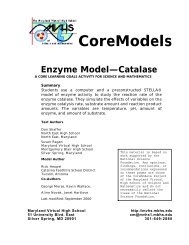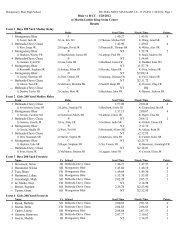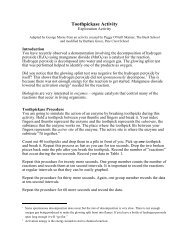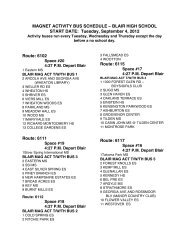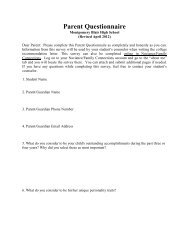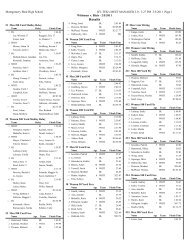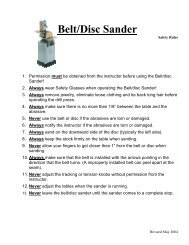The Structure and Function of Enzymes MODULE 1 MODULE 2 ...
The Structure and Function of Enzymes MODULE 1 MODULE 2 ...
The Structure and Function of Enzymes MODULE 1 MODULE 2 ...
You also want an ePaper? Increase the reach of your titles
YUMPU automatically turns print PDFs into web optimized ePapers that Google loves.
Goal 3 <strong>The</strong> student will demonstrate the ability to use the scientific skills <strong>and</strong>process <strong>and</strong> major biological concepts to explain the uniqueness <strong>and</strong>interdependence <strong>of</strong> living organisms, their interactions with theenvironment, <strong>and</strong> the continuation <strong>of</strong> life on earth.3.1 <strong>The</strong> student will be able to explain the correlation between the structure <strong>and</strong>function <strong>of</strong> biologically important molecules <strong>and</strong> their relationship to cellprocesses.3.1.1 <strong>The</strong> student will be able to describe the unique characteristics <strong>of</strong> chemicalcompounds <strong>and</strong> macromolecules utilized by living systems. [structural <strong>and</strong>functional role <strong>of</strong> enzymes]3.1.2 <strong>The</strong> student will be able to discuss factors involved in the regulation <strong>of</strong>chemical activity as part <strong>of</strong> a homeostatic mechanism [enzyme regulation:effect <strong>of</strong> temperature on enzyme activity]3.2 <strong>The</strong> student will demonstrate an underst<strong>and</strong>ing that all organisms arecomposed <strong>of</strong> cells which can function independently or as part <strong>of</strong>multicellular organisms.3.2.2 <strong>The</strong> student will conclude that cells exist within a narrow range <strong>of</strong>environmental conditions <strong>and</strong> changes to that environment, either naturallyoccurring or induced, may cause death <strong>of</strong> the cell or organism. (pH)3.3 <strong>The</strong> student will analyze how traits are inherited <strong>and</strong> passed on from onegeneration to another3..3.4 <strong>The</strong> student will interpret how the effect <strong>of</strong> gene alteration through naturalor technological advances may have beneficial or harmful effects on theindividual, society, <strong>and</strong>/or environment [mutations]Technology needed in unit modulesSTELLA s<strong>of</strong>tware, Inspiration s<strong>of</strong>tware, <strong>and</strong> Internet access are needed. Graphingcalculators <strong>and</strong> CBL probes can supplement some <strong>of</strong> the activities.Technology-enhanced instructional strategies employedStudents participate in telecollaboration <strong>and</strong> telecommunication to review theirwork <strong>and</strong> receive prompt feedback on their work. Inspiration is used to accessprior knowledge during engagement activities <strong>and</strong> organize information during theexplanation phases <strong>of</strong> instruction. STELLA computer s<strong>of</strong>tware exposes students tosystems dynamics thinking <strong>and</strong> computer modeling.Title <strong>of</strong> Each Module:Module 1: What Are <strong>Enzymes</strong> Made Of?Module 2: What Do <strong>Enzymes</strong> Do <strong>and</strong> How Do <strong>The</strong>y Do It?Module 3: What Affects the <strong>Function</strong> <strong>of</strong> An Enzyme?Unit Culminating Activity:<strong>Enzymes</strong> are usually studied as part <strong>of</strong> a larger unit, biochemistry. <strong>The</strong> unitculminating activity should be the integration <strong>of</strong> application or higher orderquestions on the biochemistry test or project.Unit Author: George L. Morse4





